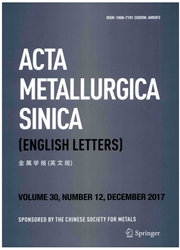

 中文摘要:
中文摘要:
Both the solid solution and precipitation are mainly strengthening mechanism for the magnesium-based alloys. A great number of alloying elements can be dissolved into the Mg matrix to form the solutes and precipitates.Moreover, the type of precipitates varies with different alloying elements and heat treatments, which makes it quite difficult to understand the formation mechanism of the precipitates in Mg-based alloys in depth. Thus, it is very hard to give a systematical regularity in precipitation process for the Mg-based alloys. This review is mainly focused on the formation and microstructural evolution of the precipitates, as a hot topic for the past few years, including Guinier-Preston Zones, quasicrystals and long-period stacking ordered phases formed in a number of Mg-TM-RE alloy systems, where TM = Al, Zn, Zr and RE = Y,Gd, Hd, Ce and La.
 英文摘要:
英文摘要:
Both the solid solution and precipitation are mainly strengthening mechanism for the magnesium-based alloys. A great number of alloying elements can be dissolved into the Mg matrix to form the solutes and precipitates.Moreover, the type of precipitates varies with different alloying elements and heat treatments, which makes it quite difficult to understand the formation mechanism of the precipitates in Mg-based alloys in depth. Thus, it is very hard to give a systematical regularity in precipitation process for the Mg-based alloys. This review is mainly focused on the formation and microstructural evolution of the precipitates, as a hot topic for the past few years, including Guinier-Preston Zones, quasicrystals and long-period stacking ordered phases formed in a number of Mg-TM-RE alloy systems, where TM = Al, Zn, Zr and RE = Y,Gd, Hd, Ce and La.
 同期刊论文项目
同期刊论文项目
 同项目期刊论文
同项目期刊论文
 A review about effects of icosahedral phase formation on the microstructure and mechanical improveme
A review about effects of icosahedral phase formation on the microstructure and mechanical improveme Relationship between fatigue crack initiation and activated {1 0 (1)over-bar 2} twins in as-extruded
Relationship between fatigue crack initiation and activated {1 0 (1)over-bar 2} twins in as-extruded Relationship between fatigue crack initiation and activated {10-12} twins in as-extruded pure magnes
Relationship between fatigue crack initiation and activated {10-12} twins in as-extruded pure magnes Effect of long-period stacking ordered phase on microstructure, mechanical property and corrosion re
Effect of long-period stacking ordered phase on microstructure, mechanical property and corrosion re Effect of icosahedral phase on the thermal stability and ageing response of a duplex structured Mg-L
Effect of icosahedral phase on the thermal stability and ageing response of a duplex structured Mg-L Effect of heat treatment on the corrosion resistance and mechanical properties of an as-forged Mg–Zn
Effect of heat treatment on the corrosion resistance and mechanical properties of an as-forged Mg–Zn Mechanical properties of the icosahedral phase reinforced duplex Mg–Li alloy both at room and elevat
Mechanical properties of the icosahedral phase reinforced duplex Mg–Li alloy both at room and elevat Mechanical properties of the icosahedral phase reinforced duplex Mg-Li alloy both at room and elevat
Mechanical properties of the icosahedral phase reinforced duplex Mg-Li alloy both at room and elevat Effect of icosahedral phase on the thermal stability and ageing response of a duplex structured Mg–L
Effect of icosahedral phase on the thermal stability and ageing response of a duplex structured Mg–L 期刊信息
期刊信息
